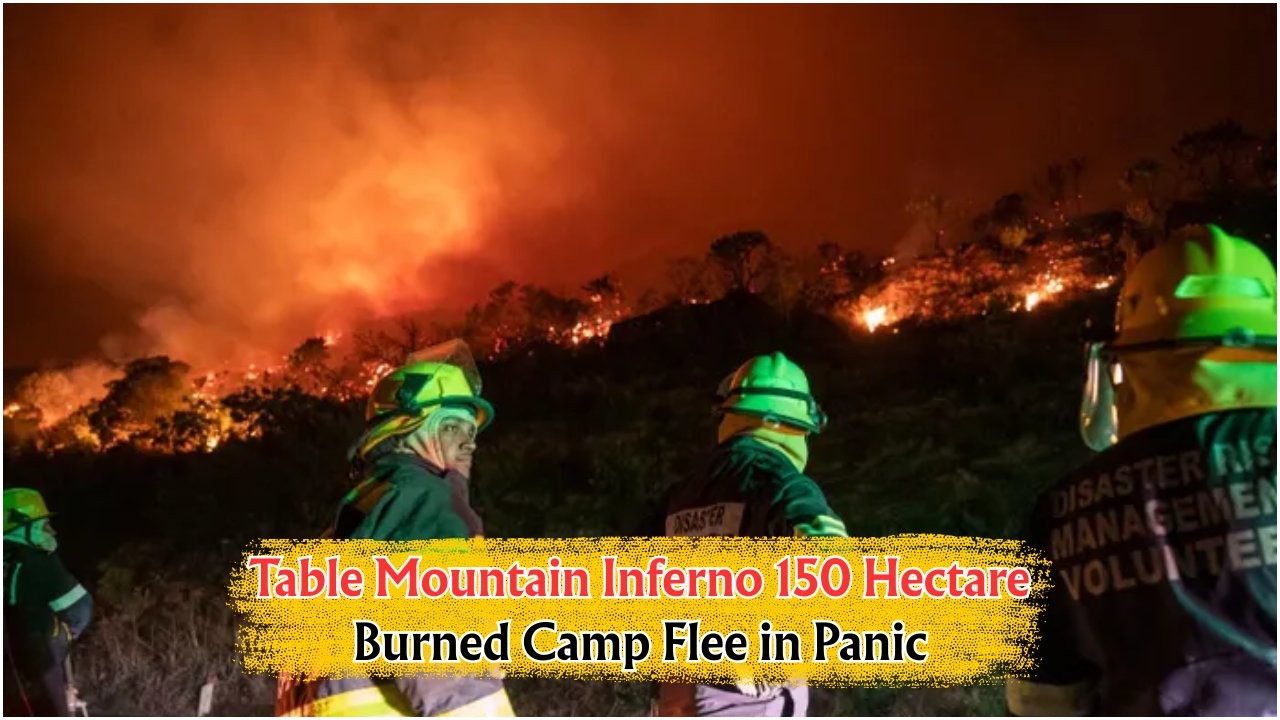July Wildfire on Table Mountain: South Africa’s beloved Table Mountain became a scene of devastation in July when a fierce wildfire swept across 150 hectares of its iconic landscape. The blaze, which erupted with alarming speed, forced the closure of popular campsites and trails, disrupting both local and international visitors who flock to the area for its natural beauty. With plumes of smoke visible from as far as Cape Town’s city center, the wildfire has raised urgent questions about prevention and response strategies to protect this treasured natural landmark.
Impact of the Wildfire on Table Mountain’s Ecosystem
The wildfire on Table Mountain not only charred vast tracts of vegetation but also posed a significant threat to the mountain’s unique biodiversity. Home to a variety of endemic species, the sudden blaze disrupted habitats and could have long-term repercussions for the flora and fauna. The fynbos, a type of vegetation indigenous to the region, is adapted to periodic fires, but the intensity and frequency of such wildfires can lead to catastrophic consequences. Conservationists are particularly concerned about the effects on animal species that rely on the specific plant life that was destroyed.
- Loss of habitat for native species
- Potential for soil erosion due to vegetation loss
- Disruption of the natural fire cycle
- Impact on water catchment areas
- Threat to endangered plant species
Response and Recovery Efforts Post-Wildfire
In the aftermath of the July wildfire on Table Mountain, local authorities and conservation groups have been working tirelessly to assess the damage and begin the recovery process. Firefighters from across the region, alongside volunteers, played a crucial role in containing the fire, preventing it from spreading to nearby residential areas. The South African National Parks (SANParks) has initiated a series of measures to rehabilitate the affected areas, including replanting native species and implementing erosion control strategies.
- Deployment of firefighting teams
- Community volunteer efforts
- Rehabilitation of affected areas
- Replanting of native fynbos species
- Implementation of erosion control measures
Tourism Impact and Camp Closures Due to the Wildfire
As a result of the devastating wildfire, several campsites and hiking trails on Table Mountain have been temporarily closed to ensure the safety of visitors and allow for restoration work. This has had a significant impact on tourism, a vital sector for the local economy. Tour operators and businesses that rely on the influx of visitors have expressed concerns over the financial implications of these closures, urging for swift action to restore access to these natural attractions.
Tourism Recovery Plans
- Collaboration with local businesses to promote alternative attractions
- Development of new safety protocols for visitors
- Efforts to reopen affected areas as soon as safe
- Marketing campaigns focusing on sustainable tourism
- Community engagement to support local businesses
Wildfire Prevention Strategies for Table Mountain
The wildfire on Table Mountain has underscored the need for improved prevention strategies to safeguard against future incidents. Experts advocate for a comprehensive approach that includes controlled burns, increased surveillance, and public education campaigns. The integration of advanced technology such as satellite monitoring and AI-driven fire detection systems is also being explored to provide early warnings and enhance response times.
- Implementation of controlled burns
- Enhanced surveillance measures
- Public education on fire safety
- Use of satellite monitoring technology
- AI-driven fire detection systems
Prevention Measures Table
| Measure | Details |
|---|---|
| Controlled Burns | Periodic burns to manage vegetation |
| Surveillance | Increased patrolling and monitoring |
| Public Education | Campaigns on fire safety practices |
| Satellite Monitoring | Real-time fire tracking |
| AI Detection | Early warning systems |
Community Involvement in Wildfire Management
Community engagement is critical in managing and preventing wildfires on Table Mountain. Local residents and visitors are encouraged to participate in awareness programs and collaborate with authorities to ensure the preservation of this natural heritage. By fostering a sense of collective responsibility, the community can play a pivotal role in protecting the mountain from future threats.
Community Initiatives
- Volunteer firefighting programs
- Neighborhood watch schemes
- Fire safety workshops
- Community clean-up events
- Local conservation projects
Future Outlook for Table Mountain’s Recovery
The path to recovery for Table Mountain is expected to be gradual, with long-term efforts necessary to restore its ecological balance. The focus will be on sustainable practices that not only rehabilitate the environment but also ensure that the mountain remains a thriving destination for future generations. With ongoing support from the government, local organizations, and the public, there is hope for a resilient resurgence.
| Recovery Aspect | Focus Area |
|---|---|
| Ecological | Replanting and habitat restoration |
| Tourism | Safe access and visitor experience |
| Community | Engagement and education |
| Infrastructure | Rebuilding and enhancement |
FAQ Section on Table Mountain Wildfire
What caused the wildfire on Table Mountain?
The exact cause of the wildfire is still under investigation, although human activities and weather conditions are being considered.
How long will the recovery take?
Recovery efforts are anticipated to take several months to years, depending on the extent of the damage and resources available.
Can visitors still access Table Mountain?
While some areas remain closed, alternative trails and attractions are open to visitors. Safety is a priority.
What measures are in place to prevent future wildfires?
Authorities are implementing controlled burns, enhancing surveillance, and launching public education campaigns.
How can the community help in recovery efforts?
Community members can volunteer for clean-up operations, attend fire safety workshops, and support local conservation projects.







